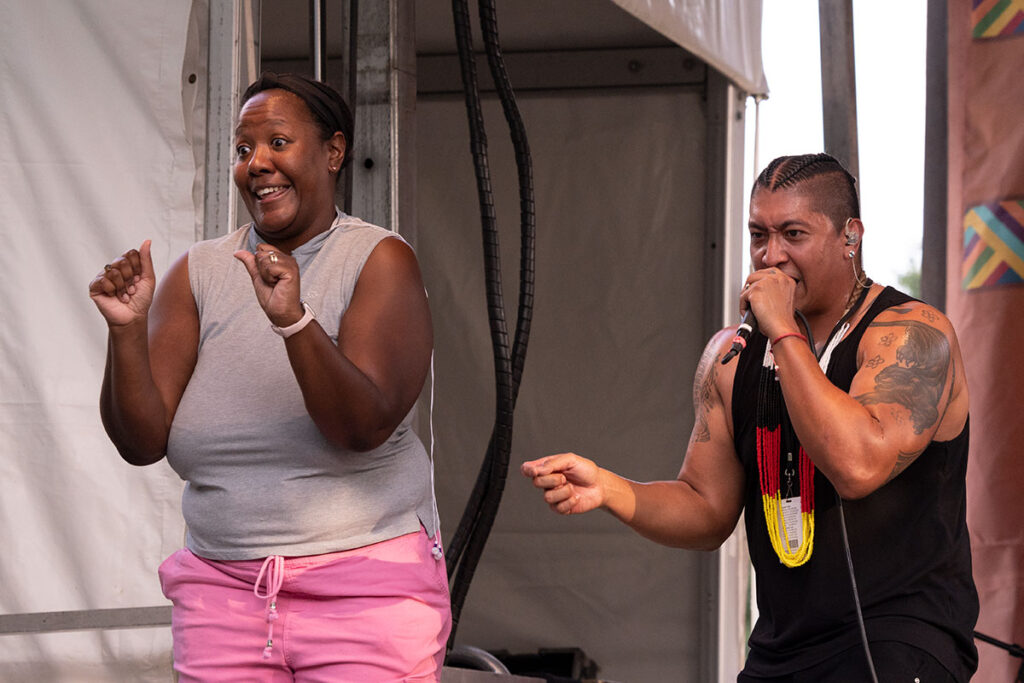Ayisha Knight-Shaw Supports Deaf Access in a Native Space

Ayisha Knight-Shaw chuckled when I asked how she found herself working in accessibility.
“I’ve always been in the field of accessibility, to be honest!” she signed.
We sat face to face, swathed in the amber light filtering through the branches above us, and boxed in by the tents of the Indigenous Voices of the Americas program at the 2024 Smithsonian Folklife Festival. Sitting next to me, an American Sign Language interpreter translated the conversation between us. We settled on the facts but soon arrived at a more personal place as Knight-Shaw described her work.
“As a person who’s Deaf and Indigenous, my goal is to teach interpreters how to sign the way an Indigenous person would sign, whether it be at the sweat lodge, whether somebody is Navajo or Choctaw or Chickasaw. It’s important that they know those signs.” She spells out her own nation in ASL letter by letter, C-H-E-R-O-K-E-E.
This year, Knight-Shaw served as the Festival’s director of artistic sign language, operating at the intersection of Indigeneity and Deaf access.
ASL is an ever-evolving language, and the sign for Native American has changed over time. Knight-Shaw was eager to teach the Smithsonian’s team of fifteen ASL interpreters, two of whom are Deaf, a new sign for Indigenous, meaning “rooted in the land.” She demonstrated by planting the fingers of one hand securely into the spaces between the fingers of her other hand. Thus grounded, the new sign, which used to refer to indigenous plants, has come to represent the belonging of Indigenous cultures to the land.
Several years ago, Knight-Shaw experienced one such moment of belonging at the Womyn’s Music Festival in Michigan within the earthy, sage-scented darkness of an all-Indigenous women’s sweat lodge. Out of the blackness, she saw a small candle flame come to life, illuminating a circle of Indigenous women praying together, sharing stories, and experiencing rituals. Normally, sweat lodges are kept completely dark as those taking part in ceremonies often tell personal stories. The darkness brings a degree of anonymity. But on this day, the elders brought in light. This accessibility allowed Knight-Shaw to participate within the circle, watching as an interpreter translated the stories for her.
“You have to sit in a circle, once you’re in the sweat lodge, which is really convenient for Deaf culture as well. Sitting in a circle allows for great communication!” She makes the ASL sign for sweat lodge, building a roof-like shape by merging her fingers.
“It was an intense experience for me,” she says, describing the thick smell of smoke, sage, sweetgrass,and other ceremonial herbs. In preparation for the sweat lodge ceremony, women gathered hardwood and pine branches and bound them together along with blankets and other natural materials to form the low-hanging, womb-like dome of the lodge. “I was thrilled because I was able to see the stories that were happening and be a part of the songs. Having that experience as a Deaf, Indigenous woman with other Indigenous women was unbelievable. That energy will never leave me.” After the festival, Knight-Shaw carried her memories home, tucking them away to fuel future work.
At the Folklife Festival, the accessibility team strives to provide resources to ensure the annual event remains as inclusive as possible. The 2024 program marked the first time the team brought in a cultural consultant for ASL. As a subject-matter expert, Knight-Shaw’s input was “paramount,” says Joi Bannister, the CEO of Joyful Signing, which has provided ASL services for the Festival and other Smithsonian events for several years. Knight-Shaw ensured that the ASL services provided were culturally appropriate, and she taught valuable information and vocabulary for ASL signs.

Bannister and the Festival’s accessibility staff anticipate that Knight-Shaw’s efforts have “set the stage” and will one day be the new standard for cultural festivals and gatherings. Visitors will return to their communities, Bannister hopes, and “be a voice to say, ‘You know what I saw when I came to the Folklife Festival? I saw access.’”
Before the Festival even began, Knight-Shaw co-hosted a free online workshop to prep ASL interpreters for interpreting in a Native space. When an interpreter is translating a performance, narrative session, or cooking demonstration at the Folklife Festival, Knight-Shaw tells me it’s important that the “register is being matched” by the interpreter. She gestures behind us for an example, to where the sandstone building of the National Museum of the American Indian sits.
“So for here in the museum stage, you need an interpreter whose signing is more formalized and big, and in a poetic way, if it’s a storytelling or a concert,” she explains. She demonstrates this by using her whole body to sign eagle, a significant animal in many Native American cultures: a hooked eagle beak with her pointer finger in front of her nose, then the movements of the soaring bird with her arms.
“The interpreter literally becomes the eagle,” Knight-Shaw says, “and represents the eagle in the way they’re signing and the way their body moves.”
Her background in theater and performing arts gives her an intuitive understanding of crowds and stages. “You have to match your audience,” she explains. “Even if the audience is mostly adults, the signing shouldn’t feel like a lecture.” Interpreters are storytellers, too.




But what happens when an ASL interpreter doesn’t speak a Native language? To keep the interpretation from feeling “sticky,” or puzzling, Knight-Shaw tells me an essential component of smooth translations is not just the hands but the eyes. Eye contact signifies many things that words and signs sometimes cannot, from emotions like sadness or excitement, to rapt attention and connection. By maintaining eye contact, the translator lets the audience know what they feel and includes them in the conversation.
“You may not understand the [spoken] language but show with your body if it’s heavy drum music or soft sounding flute. Showing in your body what you’re feeling is critical for someone who cannot hear like myself.” This could be through a facial expression that indicates strong emotion, hand movements that are soft and light, or shoulders held heavy and tense.
“Having a song sung in an Indigenous language is incredibly powerful, especially given the history of having Indigenous languages purposefully taken away from the people who spoke them,” Knight-Shaw says.
For her, being surrounded by Indigenous cultures—and seeing participants from her own nation, like the Cherokee storyteller Robert Lewis and chef Nico Albert Williams—was like reuniting with family. “It felt like home being here,” she explains, moving her hand in a flat O handshape from her mouth to her ear, in the sign for home. “There was no one who was left out. It was very inclusive, and regardless of what nation you come from, we’re all one. That meant a lot for me, because so many Indigenous people have felt pushed out and ignored, but being here at this festival was just a feeling of inclusivity and welcoming.”
One concert in particular left her awestruck. Doc Native, a Seminole rapper, and his brother Spencer Battiest, performed their original songs alongside Navajo dancers Kenneth Shirley and Dominic Pablo. Layer upon layer of colorful feathers and ribbons in the dancers’ full regalia floated rhythmically through the air, capturing her eyes. “I loved how visual they were,” she says, recalling how the feathers and ribbons moved mesmerizingly to the beat of the music and the dancers’ stamping feet. Even when she could not hear the music, the dancers let her see it.

During his rap performance, Doc Native paused. “Hold on,” he said to the audience. “I want to show you something.” He laid his mic down on the stage floor and signed in ASL: my name is D-O-C, followed by the sign for I love you. Thank you, he signed directly to Knight-Shaw. Extremely impressed by his gesture, she responded in kind: I love you.
“I thought, wow! He spelled his name in sign language—my language. I was brought to tears. I was so moved by that gesture, I met him after the performance and said thank you for including me and making me feel so special.”
While her time at the Folklife Festival inspired and encouraged her, Knight-Shaw was equally life-giving to the spirit of the Festival and its mission.
“This space is welcoming to everybody,” she concludes. “I see the different cultures that are in this space and how we all can learn from one another. And I love that this space feels safe. The language that’s being used, whether it’s oral or visual, is respected and collaborative, and that’s what I love. Access is not only for Deaf individuals. It’s for everyone.”

Eowyn Stewart is a writing intern at the Center for Folklife and Cultural Heritage. She recently graduated with an English major and a minor in art history, and she is interested in creative writing and anthropology.






